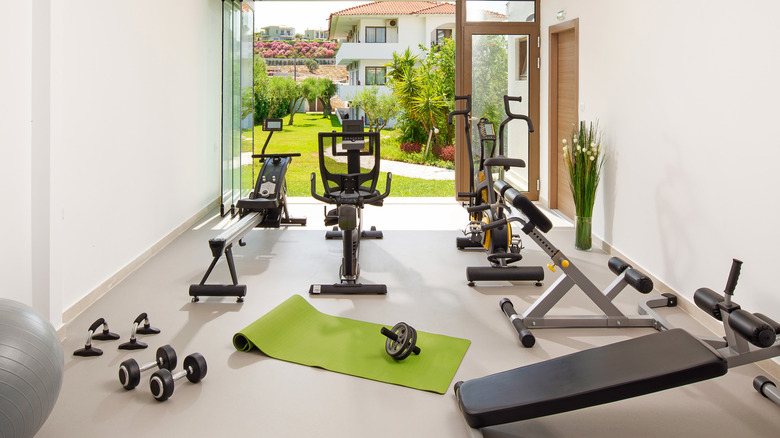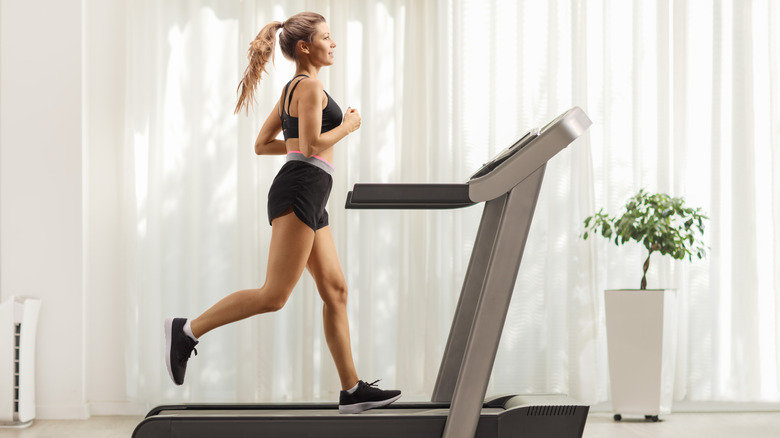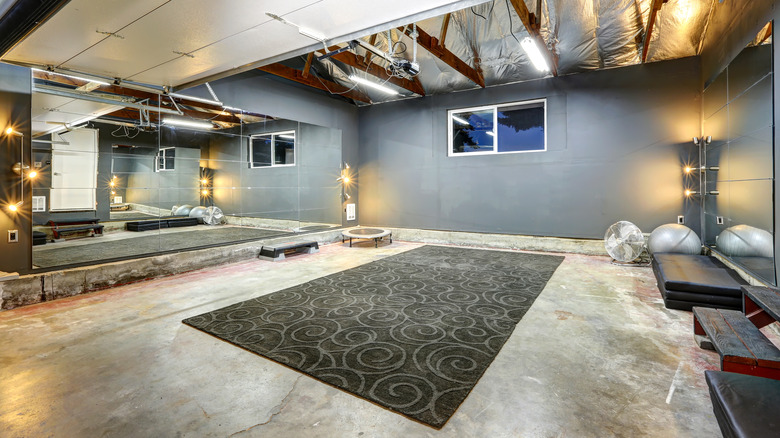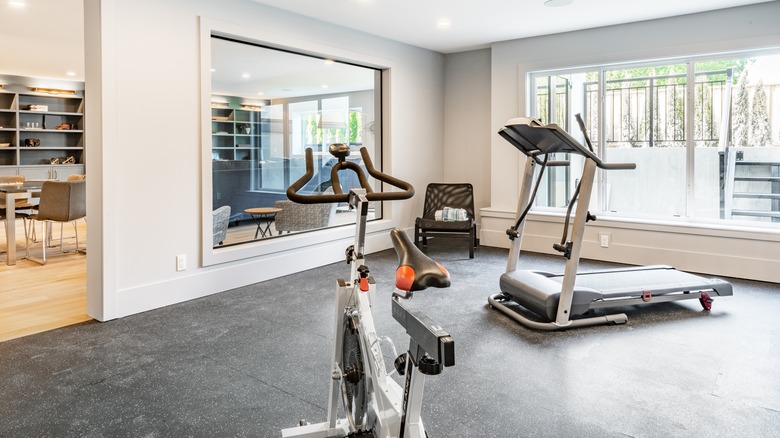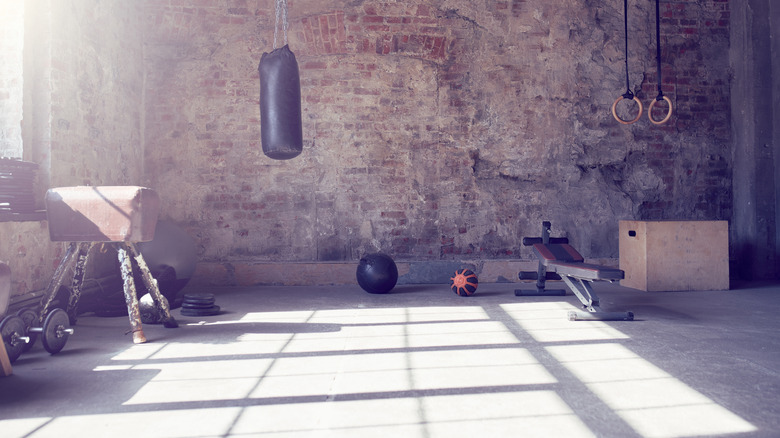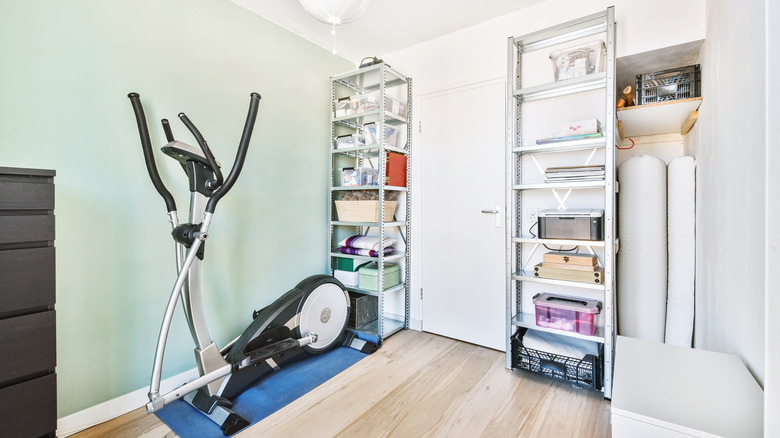A Design Expert Tells Us How To Create The Perfect Home Gym In Any Type Of Space
If the extra time traveling to the gym is taking its toll and sharing equipment with a multitude of sweaty strangers has lost its luster, consider setting up your own home gym. With a dedicated space, you'll eliminate any commuting and save money on the cost of a monthly membership. Plus, there's the added bonus of not having to adhere to a dress code and being able to get out all your grunts without feeling embarrassed. Oh, and no more waiting in line for exercise machines, according to Ironmaster.
Although larger gyms may offer a variety of fitness equipment and classes, designing an area focused on your specific workout needs allows you to personalize the space and get the most out of each session. But before shelling out any cash and knocking down walls to create your own personal training oasis, listen to some sage advice from an expert.
In an exclusive interview with House Digest, Heather Mastrangeli, the principal designer of Innovatus Design, filled us in on what to consider if you plan to create a workout area. With expertise in designing large commercial fitness centers and in-home gyms, Mastrangeli shares how to design the perfect format for your living space.
Consider the area your routine requires
Whether in a large house or a tiny apartment, you can design an ideal workout environment. However, the space you need may depend on the type of exercise you regularly do. "When designing a home gym, look for space in your home that will accommodate your planned workout routine," Mastrangeli told House Digest. "For example, if you prefer indoor cycling, then allow enough space for your bike with a stretching area to the side. If your workout style is more about HIIT [high-intensity interval training], then ensure you have space to move."
Regardless of location, it's more than possible to set up a fitness area. If you're more interested in yoga, this intentional practice can be done in any room that provides the freedom to stretch out on the floor and lift your hands high into the air. Even for activities that involve using a variety of exercise machines, you don't need a ton of square footage to see results. In fact, the recommended space can range anywhere from 35 to 200 square feet, depending on your needs, according to Garage Gym Pro. To save even more space, invest in an all-in-one training machine that lets you do multiple workouts.
Set it up on the right floor
If you live in a multi-level home and are considering where to place your gym, consider which floor would best suit it. "One mistake most people make when designing a home gym is placing it on the wrong floor," Mastrangeli says, "When jumping, squatting, doing a slam ball routine, etc., the floor needs to be steady." Although your finished attic could be ideal, people in the rooms directly below may not appreciate the thunderous noise from a treadmill or an intense workout on an exercise bike.
In these cases, "a basement floor or concrete slab will limit vibrations and noise, while a second-floor home gym may shake the house when in use," Mastrangeli notes. This makes basements a perfect spot. However, a converted garage can also be utilized to house your equipment and provide enough leeway to move around freely. If you prefer a gym upstairs or live in an apartment building, then it's worthwhile to invest in proper shock-absorbing flooring. According to Garage Gym Reviews, vinyl, rubber interlocking mats, performance turf, and even interlocking carpet tiles provide comfort and noise reduction, allowing you to create a gym in alternative areas of the home.
Bring in the right colors
There's no doubt color impacts our mood and sets the tone for the feeling of any room. According to Verywell, cooler colors, such as blues and purples, are often associated with relaxing energy and calming vibes, whereas warmer colors, including orange, red, and yellow, induce more cozy and comforting feelings. So, what tones best suit a workout area? "The colors in your home gym should be energizing and help keep you motivated," Mastrangeli explains. "This is a great place to play with color and pattern to really set the tone for a successful workout."
Thus, if you're wanting to create a space for intense workouts, stick with bright, energizing colors, like yellow or even shades of red. Colorful wall patterns could also induce a more high-energy physical session. Is low-impact conditioning and yoga more your speed? Soothing blue and purple tones can be just what's needed to create a calming environment. Conversely, if you follow the practice of feng shui, then your home gym's placement will dictate any color choices. Red works for the south and southwest sectors of your home, white and gray for the west and northwest, blue and black for the north and northeast, and finally green and purple for the east and southeast, according to Love to Know.
Make sure you have the right lighting
The lighting in any room can dramatically affect its entire appearance. When it comes to different areas of your apartment or house, you obviously want to make the most out of any available sunlight, as these rays help create an invigorating feel to gyms. However, if you decide on the basement or garage, it can be difficult for natural light to spill in. That's why it's also important to have proper light fixtures. "When planning the lighting in your home gym, look for lighting that's not directly shining down from the ceiling, such as recessed lighting," Mastrangeli says. "The light bulbs should be concealed. This will keep [the] harsh glare from your eyes, especially when laying on a mat."
Whether your space has overhead lights, floor lamps, or table lamps, consider utilizing long-lasting and flicker-free LED bulbs, which won't induce unnecessary headaches. When installed, these bulbs are often dimmable, allowing you to control the amount of lighting. According to Phillips, for the best home gym lighting, use a bulb with a Kelvin range of 2,200 K to 6,500 K.
Take advantage of any vertical space
Much like measuring the width of your home gym, it's also beneficial to also consider ceiling height in order to properly utilize every possible square inch. "Planning to hang equipment on walls and using vertical space allows you to make the most of your space," Mastrangeli says. Not only will you need adequate verticality to pop in the right kind of equipment, but you'll also want to ensure the walls and ceilings are sturdy enough to hold items like punching bags or chin-up bars.
Indeed, making the most of any vertical space is particularly important for home gyms in tight areas. However, placing a full-length mirror on a wall can make the area look larger and offer the visual accompaniment needed for certain toning exercises. When it comes to storage, hanging items on the wall is the smartest way to maintain square footage, according to Public Storage. For example, heavy-duty hooks and wall shelves help keep equipment off the floor. Similarly, instead of using an oscillating floor fan, install ceiling fans in order to declutter the area.
